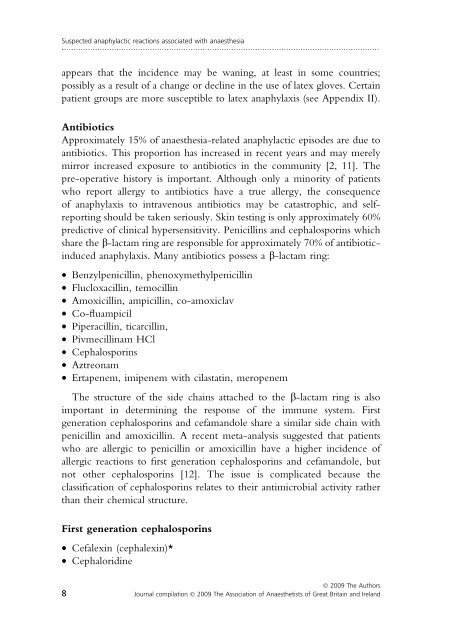Suspected anaphylactic reactions associated with anaesthesia - aagbi
Suspected anaphylactic reactions associated with anaesthesia - aagbi
Suspected anaphylactic reactions associated with anaesthesia - aagbi
- No tags were found...
You also want an ePaper? Increase the reach of your titles
YUMPU automatically turns print PDFs into web optimized ePapers that Google loves.
<strong>Suspected</strong> <strong>anaphylactic</strong> <strong>reactions</strong> <strong>associated</strong> <strong>with</strong> <strong>anaesthesia</strong>.....................................................................................................................................appears that the incidence may be waning, at least in some countries;possibly as a result of a change or decline in the use of latex gloves. Certainpatient groups are more susceptible to latex anaphylaxis (see Appendix II).AntibioticsApproximately 15% of <strong>anaesthesia</strong>-related <strong>anaphylactic</strong> episodes are due toantibiotics. This proportion has increased in recent years and may merelymirror increased exposure to antibiotics in the community [2, 11]. Thepre-operative history is important. Although only a minority of patientswho report allergy to antibiotics have a true allergy, the consequenceof anaphylaxis to intravenous antibiotics may be catastrophic, and selfreportingshould be taken seriously. Skin testing is only approximately 60%predictive of clinical hypersensitivity. Penicillins and cephalosporins whichshare the b-lactam ring are responsible for approximately 70% of antibioticinducedanaphylaxis. Many antibiotics possess a b-lactam ring:• Benzylpenicillin, phenoxymethylpenicillin• Flucloxacillin, temocillin• Amoxicillin, ampicillin, co-amoxiclav• Co-fluampicil• Piperacillin, ticarcillin,• Pivmecillinam HCl• Cephalosporins• Aztreonam• Ertapenem, imipenem <strong>with</strong> cilastatin, meropenemThe structure of the side chains attached to the b-lactam ring is alsoimportant in determining the response of the immune system. Firstgeneration cephalosporins and cefamandole share a similar side chain <strong>with</strong>penicillin and amoxicillin. A recent meta-analysis suggested that patientswho are allergic to penicillin or amoxicillin have a higher incidence ofallergic <strong>reactions</strong> to first generation cephalosporins and cefamandole, butnot other cephalosporins [12]. The issue is complicated because theclassification of cephalosporins relates to their antimicrobial activity ratherthan their chemical structure.First generation cephalosporins• Cefalexin (cephalexin)*• CephaloridineÓ 2009 The Authors8 Journal compilation Ó 2009 The Association of Anaesthetists of Great Britain and Ireland

















